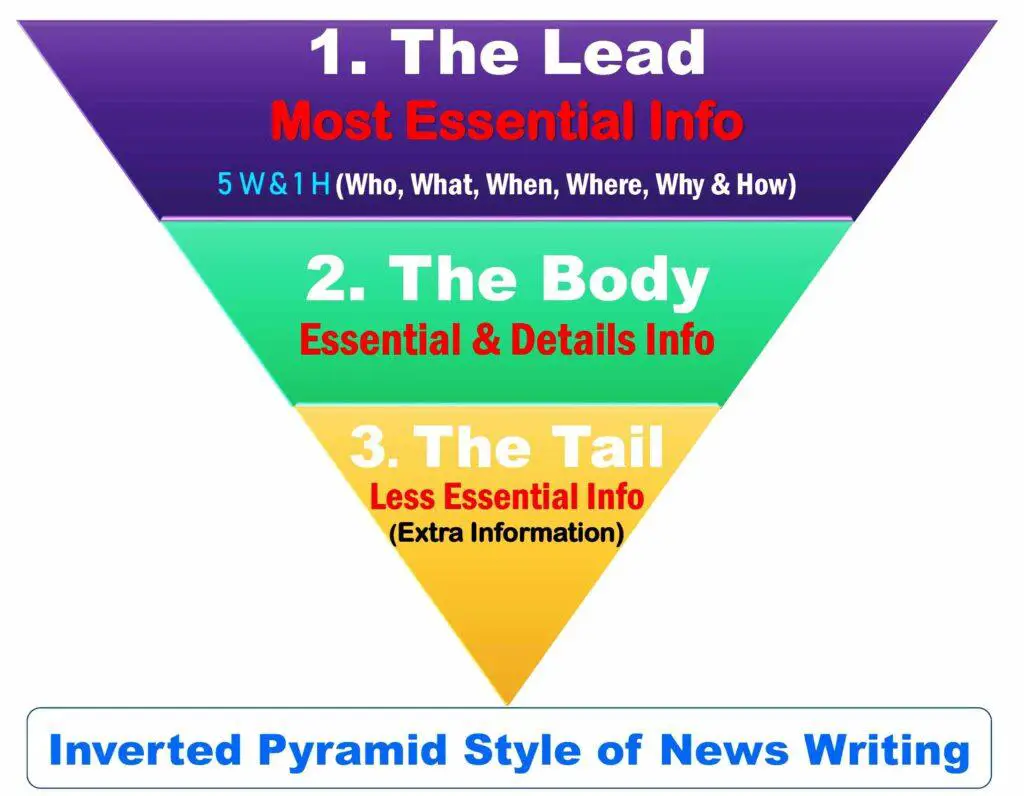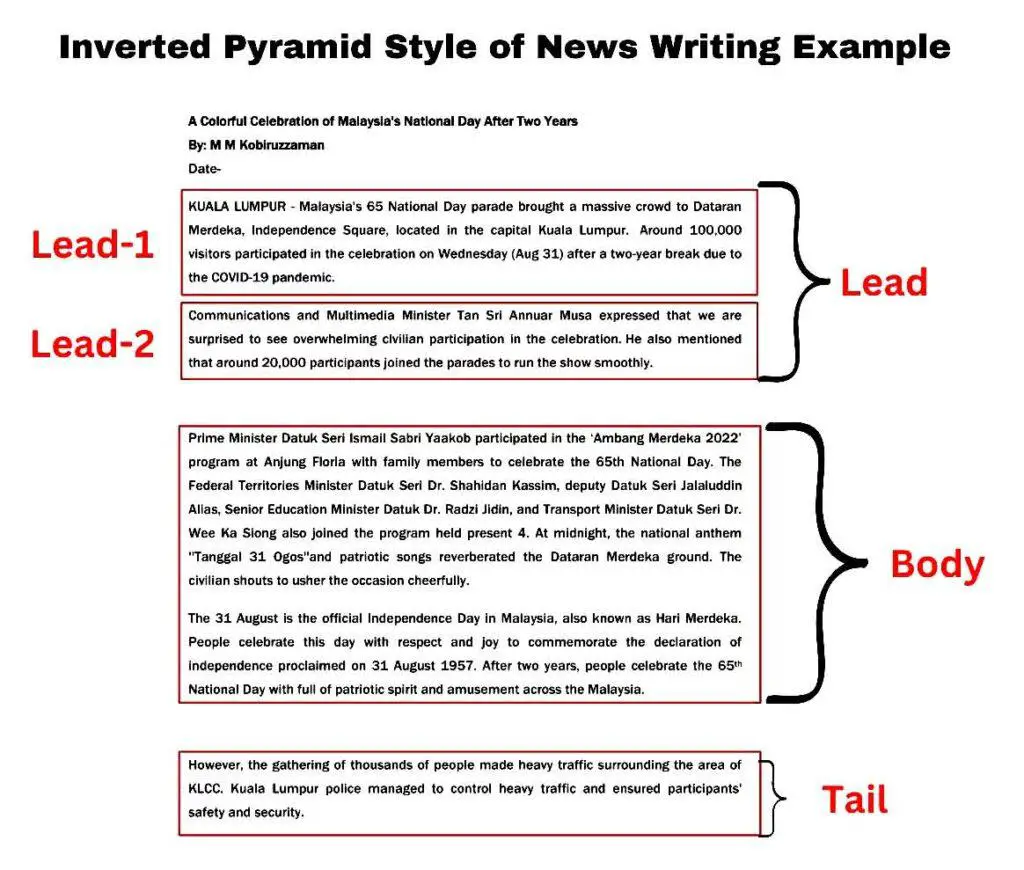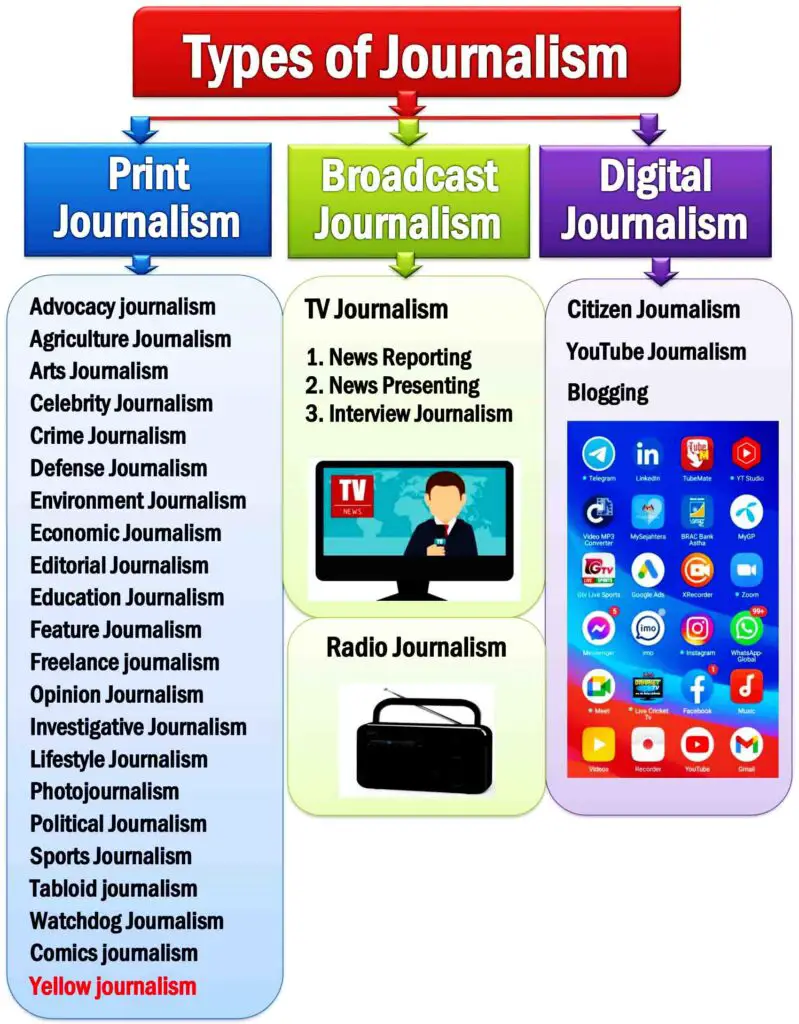Inverted Pyramid Style of News Writing Examples. Inverted Pyramid Journalism. Advantages and Disadvantages of the Inverted Pyramid.
Inverted Pyramid Style
Inverted Pyramid Style refers to the hierarchical structure of news writing in which essential information is presented before the non-essential info in the news story. According to the Inverted pyramid style, the most essential info goes to the top, followed by the less important information. Many readers read only the main point of the news mentioned in the news lead section.
The mass media journalist comprehensively follows an inverted pyramid style to write a news story. It assists writers in illustrating the most crucial information at the top of the news. This style prioritizes newsworthy information to write a news article, telegraph, blogs, editorial column, and sometimes feature articles in journalism. It is one of the most effective strategies to grab readers’ attention to read the whole story. Sometimes, authors follow the inverted pyramid formula to review journal articles in analyzing the findings and accuracy of the study. Many journalists follow this way to write news content and publish it in print media. Therefore, it is known as inverted triangle or inverted pyramid journalism.
However, researchers identify both advantages and disadvantages of the inverted pyramid style.
Inverted Pyramid History
The inverted pyramid style has been used since the invention of the telegraph in 1844. Samuel F. B. Morse invented the telegraph in 1840. However, the written message was sent for long-distance interaction in 1844. People followed the inverted pyramid style to send breaking news through the telegraph to inform others. They put essential info on top, following the non-essential information. Nowadays, journalists follow this inverted triangle style to report stories in the different types of journalism, including print, broadcast, and digital.

The inverted pyramid describes a triangle diagram pointing down feature, which is an inverted triangle writing style. The broader part of the pyramid goes top, and the narrow section goes down. It indicates that the essential news goes up to catch the reader’s attention.
Inverted Pyramid Model
The inverted pyramid framework contains three segments: the lead: the most newsworthy information; the body: essential details; and the tail: background info.
1. The Lead: Most Newsworthy Information
The Lead includes the most newsworthy information, followed by the 5w and 1h of report writing style. The journalist should answer the six questions (who, what, where, when, why, and how) to report the story. This information attracts the audience to read the entire story; hence, the writer keeps the most newsworthy words on the top of the news. The Lead segment includes around 30 words and 1-2 paragraphs. A good news lead must enclose 5w’s and 1h report writing formula. The readers can stop reading at any time; therefore, journalists put an essential fact on top of the report.
2. The Body: Essential Details
The body represents the detailed information to expand the story. It also extends the news lead to provide more background details. The main issue is illustrated in this section. It is a broader part of the report where details info is explained. The body explains the issue elaborately; therefore, it is a long paragraph.
3. The Tail: Background Info
The tail is the last part of the news report. It includes background and additional information to the story for readers. The background information keeps readers engaged with the news for a long time. The editor cuts unnecessary info from the news bottom.
In journalism, the inverted pyramid style is a strategic story structure where the most important details are presented first. The report’s 5w and 1 h questions appear at the story’s beginning, followed by supporting details and background information.
Inverted Pyramid Style of News Writing Example for Students
This example of an inverted pyramid style of news writing presents how to write a news article concisely, including the lead, body, and tail. This example also includes a heading, byline, news lead, and conclusion. It is a news writing example for students based on an inverted pyramid framework.

A Colorful Celebration of Malaysia’s National DayBy: M M KobiruzzamanUPDATED AUGUST 31, 2022, 12:13 AM The Lead: Most Essential InfoKUALA LUMPUR – Malaysia’s 65 National Day parade brought a massive crowd to Dataran Merdeka, Independence Square, located in Kuala Lumpur’s capital. Around 100,000 visitors participated in the celebration on Wednesday (Aug 31) after a two-year break due to the COVID-19 pandemic. Communications and Multimedia Minister Tan Sri Annuar Musa expressed that we are surprised to see overwhelming civilian participation in the celebration. He also mentioned that around 20,000 participants joined the parades to run the show smoothly. The Body: Details and Essential InfoPrime Minister Datuk Seri Ismail Sabri Yaakob participated in the ‘Ambang Merdeka 2022’ program at Anjung Floria with family members to celebrate the 65th National Day. The Federal Territories Minister Datuk Seri Dr. Shahidan Kassim, Deputy Datuk Seri Jalaluddin Alias, Senior Education Minister Datuk Dr. Radzi Jidin, and Transport Minister Datuk Seri Dr. Wee Ka Siong also joined the program held present 4. At midnight, the national anthem ”Tanggal 31 Ogos”and patriotic songs reverberated through the Dataran Merdeka ground—the civilians shouted to usher in the occasion cheerfully. 31 August is the official Independence Day in Malaysia, also known as Hari Merdeka. People celebrate this day with respect and joy to commemorate the Declaration of Independence on 31 August 1957. After two years, people celebrate Malaysia’s 65th National Day, full of patriotic spirit and amusement. The most fantastic event was displaying fireworks for five minutes that lit up the Kuala Lumpur sky. The program has been blessed by the clear weather, influencing people from all walks of life to cheer the crowd. Earlier, many famous local artists such as Ella, Haqiem Rusli, Man Bai, and Ameng Spring performed to treat the crowd. The most local point in Kuala Lumpur, including KLCC and the Botanical Gardens, was flooded with thousands of people to commemorate National Day. The Tail: Additional InfoHowever, the gathering of thousands of people caused heavy traffic surrounding the area of the KLCC. Kuala Lumpur police managed to control heavy traffic and ensured participants’ safety and security. |
Advantages and Disadvantages of the Inverted Pyramid Style of News Writing
The inverted pyramid is used chiefly globally in traditional print journalism frameworks for news writing. It organizes the news story chronologically and presents the news’s main point in the first paragraph, including facts and evidence. The inverted pyramid style of news writing has advantages and disadvantages in news writing.
Advantages of the Inverted Pyramid News Writing Style
Facilitates Editor
The editors can modify the headline easily if it is necessary. The headline should be based on the main point of the story. Hence, the editor can rewrite the headline based on the news lead, and they do not need the whole report. Sometimes, editors cut unnecessary info from the news Tail. The inverted pyramid style assists them in modifying news quickly.
Improve Writer Performance
The inverted pyramid style improves the author’s news writing performance. It shows them a chronological way to publish news easily. This model applies to all types of news writing, so authors follow the same structure regularly. It certainly saves time to write and deliver news content.
Improve Reader’s Comprehension
The reader can easily understand the whole topic while reading the news lead. The inverted pyramid suggests following the 5W and one H writing style, making the feature more attractive to readers.
Represent the Fact
The inverted pyramid news writing style represents the story’s facts in chronological sequence. It assists the author in identifying the uninteresting factors and separating them accordingly.
Save Time
The reader can understand the entire news story by reading the news lead, so they can decide whether to read it. They can avoid the news if the story is not essential or relevant. So it does not tire the readers.
Improve News Values
The inverted pyramid journalism certainly improves newsworthiness and news values. This model applies to all types of journalism, including Personal influence, Controversy, Suitability, Impact, and Bizarre.
Increase Revenue
The inverted pyramid news style encourages readers to narrow down to read the conclusion. The audiences spend more time online on news portals; therefore, it increases revenue.
Disadvantages of the Inverted Pyramid News Writing Style
The inverted pyramid style represents the main ideas at the top of the news; therefore, many light readers read the headline and lead and leave it. It cannot hold the audience on the same report for long. Hence, the most significant cons of the inverted pyramid style are that it provides the primary information.
No Suspense
This model does not influence to make suspense, but many readers find uncertainty in news stories. It demotivates readers from reading the news due to the suspense.
No Creativity
The writers can follow the same style to write all types of news. So, there is less opportunity to emphasize the author’s creativity. It does not influence writers to implement creativity.
Formulaic
It can tell the readers that reports are generated in the same formula. A backward style gives more value to the structure rather than facts.
No Beginning
The story has no beginning or end. It focuses on the basic rules of the inverted pyramid style while writing news rather than the beginning point of the story. It demotivates journalists to write the story from the beginning point.
In conclusion, despite the advantages and disadvantages of the inverted pyramid style of news writing, most journalists, directly and indirectly, utilize the inverted pyramid style for report writing. Also, blogger follows this strategy to write creative, educational, and feature articles.


